This step by step diy woodworking project is about worm compost bin plans. If you want to learn more about building a wooden bin, we recommend you to pay attention to the instructions described in the article. There are many other designs and plans to choose from when building projects for your backyard, so make sure you take a close look over the related plans that are featured on our site.
There are many plans and designs to choose from, so make sure you take a close look over the rest of the workshop plans featured on our website. Plan everything with attention and adjust the size and the shape of the table to suit your needs. Plumb the legs and make sure the corners are right-angled before inserting the galvanized screws into place. Drill pilot or pocket holes to prevent the wood from splitting. See all my Premium Plans HERE.
Projects made from these plans
Worm Compost Bin Plans

Building the worm compost bin
Cut & Shopping Lists
- A – 4 pieces of 4×4 lumber – 4″ long, 1 piece of 3/4″ plywood – 16 1/2″x16 1/2 long BASE
- B – 2 pieces of 1×6 – 15″ long, 2 pieces – 16 1/2″ long FRAME
- C – 2 pieces of 1×3 lumber – 16 1/2 “, 2 piece – 11 1/2″ long SUPPORTS
- D – 2 piece of 1×3 lumber – 16 1/2″ long, 2 pieces – 13 1/2″ long TOP SUPPORTS
- E – 2 pieces of 1×2 lumber – 13 1/2″ long, 2 pieces – 10 1/2″ long SUPPORTS
- F – 1 piece of 3/4″ plywood – 16 1/2″x16 1/2″ long, 2 pieces of 1×2 lumber – 13 1/2″ long LID
Tools
![]() Hammer, Tape measure, Framing square, Level
Hammer, Tape measure, Framing square, Level
![]() Miter saw, Drill machinery, Screwdriver, Sander
Miter saw, Drill machinery, Screwdriver, Sander
Time
Related
Building a compost bin
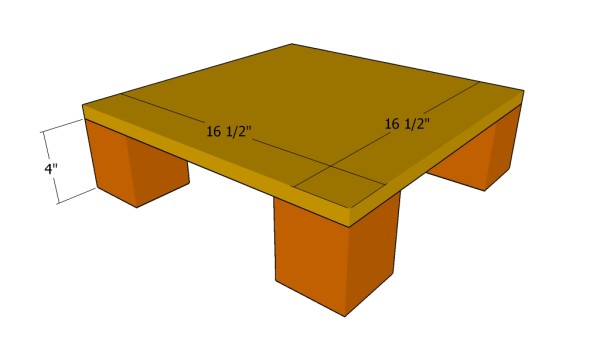
Building the base of the compost bin
The first step of the project is to build the base for the worm compost bins. As you can easily notice in the free plans, we recommend you to attach the 3/4″ plywood base to the 4×4 wooden legs. Cut the components at the right size and lock them together as in the diagram.
Drill pilot holes through the plywood and insert several 2 1/2″ screws into the wooden legs. Leave no gaps between the components and add glue to the joints.
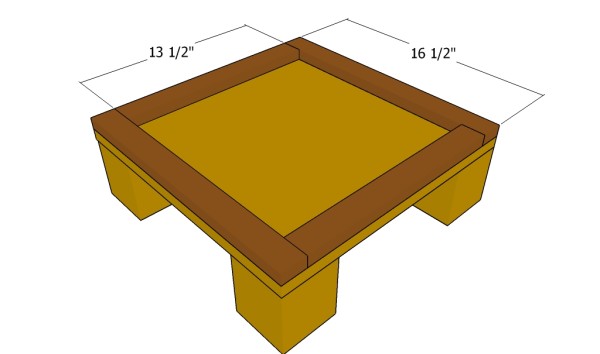
Attaching the bottom trims
The next step of the woodworking project is to attach the 1×2 trims to the base of the worm compost. Align the trims with attention, making sure they are flush with the edges and insert 1 1/4″ screws into the base. Add glue to enhance the bond of the joints.

Building the frame of the units
The next step of the woodworking project is to build the frame of the worm compost bin from 1×6 lumber. As you can easily notice in the image, we recommend you to cut the components to the dimensions described in the article.
Drill pocket holes at both ends of the red components and secure them to the perpendicular components. Make sure the corners are right-angled and insert 1 1/4″ screws to enhance the bond of the joints.
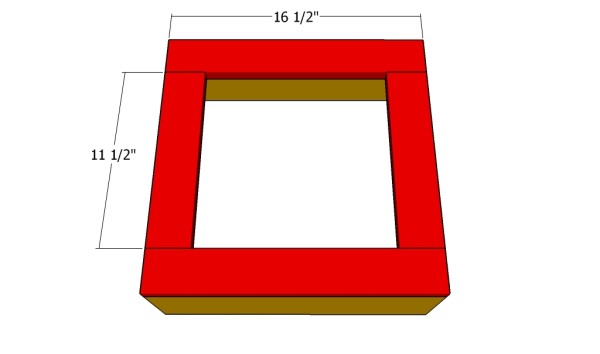
Fitting the slats
Now, it is time to build the bottom of the compost bins. In order to get a professional result, we recommend you to adjust the length of the 1×3 trims as described in the image.
If you want to get a professional result, we recommend you to lock the frame using pocket screws, before fitting it to the main unit. Smooth the edges with sandpaper and don’t leave any gaps between the components.
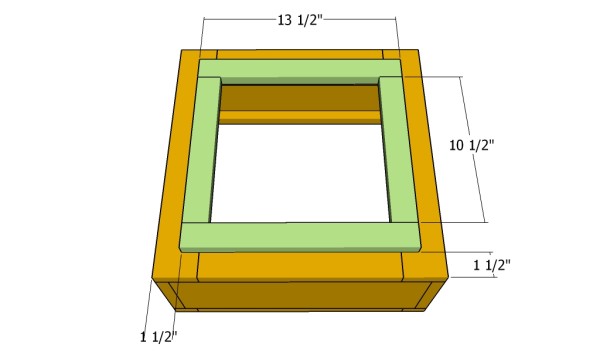
Fitting the mesh supports
Next, attach the second frame to the bottom of the main units. Build this frame out of 1×2 lumber and lock the components together tightly before fitting them to the main unit. Work with attention and leave no gaps between the components. Align everything with attention and insert the screws after drilling pilot holes, to prevent the wood from splitting.
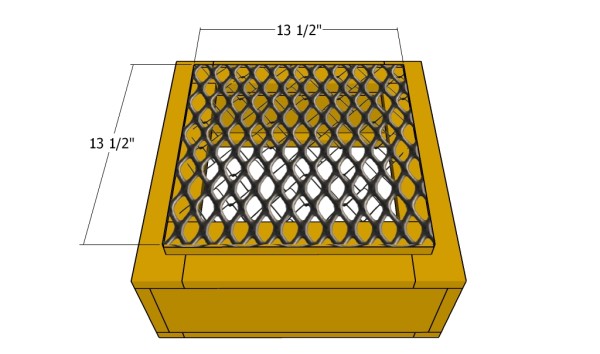
Fitting the mesh
Afterwards, attach the mesh to the second frame and staple it into place properly. It is essential to remove the excess and to make sure the mesh is secured into place tightly.
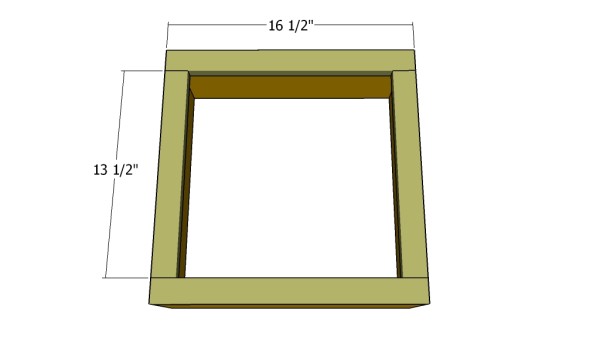
Fitting the top trims
Next, turn the main units upside-down and attach the 1×2 trims to the edges, as described in the diagram. Leave no gaps between the trims and lock them together with pocket screws before attaching them to the frame.
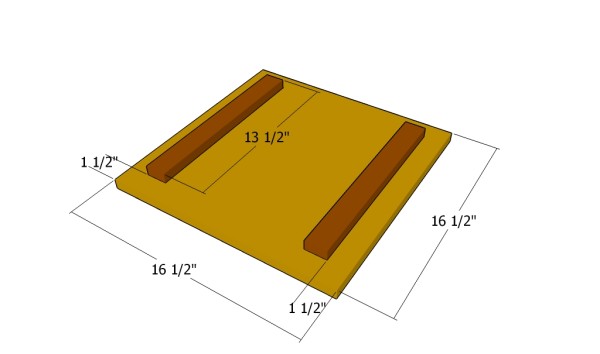
Building the top
Building the top for the worm compost bin is one of the last steps of the woodworking project. Build the top out of 3/4″ plywood and attach two 1×2 supports to it, as described in the diagram. Make sure you align the components with attention and lock them together tightly. Build as many main units as you want, before assembling the bin.
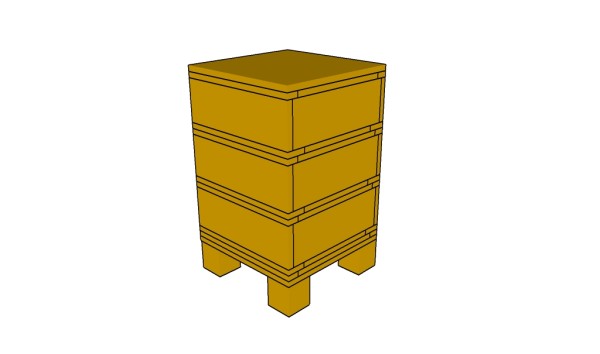
Worm compost bin plans
One of the last steps of the woodworking project is to take care of the finishing touches. Therefore, fill the pilot holes with wood putty and smooth the surface with 120-grit sandpaper.
Top Tip: If you want to enhance the look of the woodworking project and to protect the table from decay, we recommend you to cover the components with paint (make sure the pain is toxin-free). Place the bin in a proper location.
This woodworking project was about worm compost bin plans. If you want to see more outdoor plans, we recommend you to check out the rest of our step by step projects. LIKE us on Facebook and Google + to be the first that gets out latest projects.

2 comments
what type of mesh did you use? i don’t see that on the materials list.
Something like this: http://amzn.to/2qwdtll